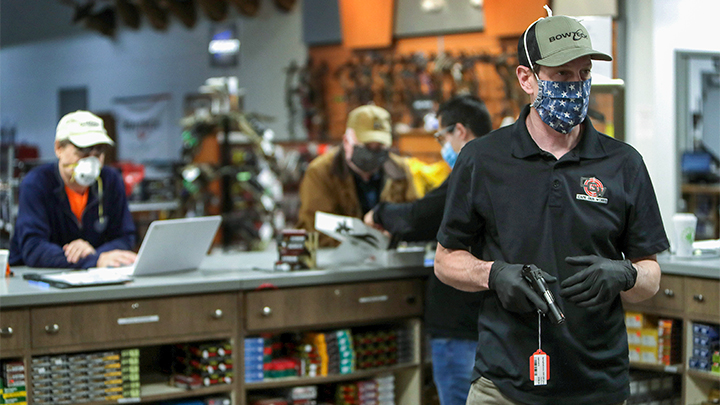
The COVID-19 pandemic has inflicted unspeakable pain on Americans by stealing jobs, homes, businesses and loved ones in recent months. But fears that it would also spark social unrest triggered huge sales of firearms and ammunition across the United States. In turn, those sales likely generated record funding for hunting, shooting and wildlife-management programs through the Pittman-Robertson Federal Aid in Wildlife Restoration Act.
That somber silver lining seems certain based on record-setting firearm-related background checks for March and April 2020. Data for May weren’t available for this report.
The National Shooting Sports Foundation (NSSF) tracks potential gun-buyer numbers through data compiled by the FBI’s National Instant Criminal Background Check System, or NICS. To fine-tune that data, the NSSF subtracts background checks that likely don’t involve a gun purchase, such as applications and renewals for concealed-carry weapon permits.
The NSSF is the trade group representing firearm and ammunition manufacturers. It cautions that its “adjusted” data on background checks do not directly correlate to firearm sales or sales dollars.
Setting Records
Even so, the numbers provide insights into market conditions, and show an all-time one-month-record 2.38 million background checks in March 2020 and a No. 4 all-time 1.68 million checks for April.
The NSSF recorded only two other months the past 22 years when background checks exceeded 2 million: 2.24 million in December 2012 (No. 2 all time) and 2.24 in December 2015 (No. 3 all time). March and April 2020 also combined for an all-time two-month record 4.05 million background checks. That’s nearly 26,000 higher than the previous two-month record of 4.03 million, set in December 2012 and January 2013 after President Barak Obama’s re-election.
Further, the FBI’s unadjusted NICS data show March’s background checks were so brisk that five straight days—March 17-21—ranked among the program’s 10 busiest days dating to November 1998. The FBI processed a single-day record 210,308 background checks on March 20, which is 3.55 percent more than the second-busiest day (203,086 checks) in the program’s history, Nov. 24, 2017.

Five of the top-10 busiest weeks in the program’s history also occurred during the pandemic’s first two months. That included the record week of March 16-22 with 1.2 million background checks, which was 26 percent higher than the second-busiest week in background-check history, Dec. 17-23, 2012, when the FBI processed 953,613 requests.
Based on the NSSF’s adjusted data, the top five states seeking background checks in March were Texas, 238,523; Florida, 175,521; California, 136,705; Pennsylvania, 104,415; and Ohio, 101,845. Those states totaled 757,009 checks, an 86 percent increase from their combined 407,593 background checks in March 2019.
Sales Look Strong
Industry analysts, meanwhile, calculated huge increases in sales during the pandemic, especially when compared to winter-spring sales in 2019. First-time gun buyers and handgun purchases drove much of the increase.
Small Arms Analytics and Forecasting consultants estimated April’s firearm sales at 1.8 million units, a 71 percent increase from April 2019. It estimated April’s handgun sales at 1.08 million, an 83 percent increase from April 2019; and rifle/shotgun sales at 560,353, a 52 percent increase from April 2019.
Data from the National Association of Sporting Goods Wholesalers also reported that ammo sales for the first three months of 2020 were up 49 percent when compared to the previous three-year average; and 188 percent in week-over-week growth for the week ending March 21, growing from $9.9 million to $18.6 million.
Pittman-Robertson Contributions
The feds won’t know until midsummer how those sales and background checks translated into actual dollars and Pittman-Robertson federal excise taxes.
Preliminary P-R receipts for 2020’s first quarter were nearly identical to the final quarter of 2019. The first quarter, which ended March 31, showed $149.69 million in FET on the sales of handguns, rifles, shotguns and ammunition. That’s a 9.15 percent increase from $137.14 million in FET during 2019’s first quarter, but slightly down from $150.22 million in FET for the fourth quarter, which ended Dec. 31.
Those numbers might be attributed to a modest start in January and February. The NSSF-adjusted background checks those two months totaled 2.47 million, roughly 90,000 shy of March alone. Background checks for January-February were also 15 percent lower than the November-December totals (2.9 million).
The P-R Act was enacted in 1937 to provide consistent, long-term funding for the nation’s conservation programs. It levies an 11 percent federal tax when a rifle, shotgun or handgun, or ammunition or archery gear, are first sold. The IRS collects the taxes for the U.S. Fish and Wildlife Service, which then distributes the revenue to state wildlife agencies for research, wildlife management, shooting ranges and hunter-education programs. State allocations are based on their land size and hunting-license sales.
Funds generated by the P-R Act cannot be diverted by Congress or federal agencies to anything not related to bird and mammal conservation. Although various raiders have tried tapping into that funding the past 83 years, citizen-hunter organizations rallied to stop them while working with lawmakers to eliminate possible loopholes.
• Ammo and handgun sales are subject to the same 11 percent Pittman-Robertson federal excise tax as rifles and shotguns, even though relatively few hunters carry handguns. Most handguns are purchased for personal protection; target shooters and handgun enthusiasts shoot more ammo than do hunters. In fact, recent studies indicate roughly 60 percent of firearm owners don’t hunt.




































